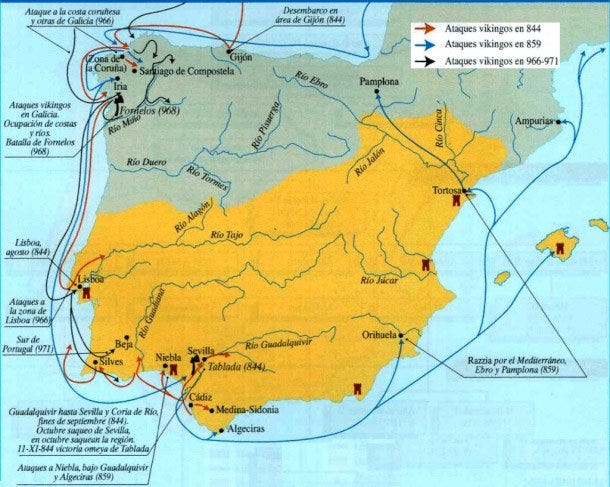Ya’qubi (died 897/8), also referred to as al-Yaʿqūbī, was an Arab Muslim Geographer born in Baghdad. Introduction to a recent publication of his work states the following: “… al-Yaʿqūbī was of notable Iraqi birth and education, and spent much of his professional life in the employment of provincial governing families of the late ninth-century Abbāsid empire. His own statements indicate that he worked in Armenia…” His Kitāb al-Buldān (Geography) “is properly described as an ‘imperial’ digest. Composed perhaps in the final decade or so of the ninth century AD, by which time the author may have been in residence in Egypt, it provides detailed descriptions of the major towns and cities of the contemporary Abbāsid Empire… The Buldān thus offers much practical data, and Ibn Wāḍiḥ’s eye for detail is impressive.” Here is the famous quote from that book about the raid: “West of the city of Algeciras is a city called Seville. It is on a large river which is also the river of Cordoba. In the year 229 (844 AD) the pagans (majus) who are called al-Rūs entered the city, took prisoners, looted, burned, and killed.” (The Geography)
T. J. Hraundal in his Ph.D. Dissertation ‘The Rus in Arabic Sources‘ noted that “the event Al-Ya‘qubi describes, the attack on Seville in 844/5, was obviously noteworthy and quite naturally included in his account of Al-Andalus, which is however rather short. This surprisingly successful attack, when we compare the size of the Muslim army to that of the Rus, proved to be a memorable event. Indeed several later historians such as Razi and Ibn al-Qutiyya include it in their accounts. The latter tells us that it caused such alarm that it prompted the erection of a fortified wall by the Emir Abd al-Rahman II.”
The editors of the book quoted above explained their translation of majus as pagans (Arab. al-majus alladhina yuqal lahum ar-rus) in the following way: “Majus in this context refers not to the Zoroastrians of Iran, but to the Vikings, as does the term Ris. Al-Ya‘qubi is referring to the attack on Seville by Norse Vikings. After appearing in the estuary of the Tagus in August 844, the Viking fleet of 54 longboats sailed south and then up the Guadaquivir, arriving at Seville in October 844 and subjecting the city to seven days of mayhem. It was not until the following month that Abd al-Rahman inflicted a defeat on them, forcing the survivors to flee.”
The translators contradict themselves because, at the end of Volume Three, they note that ‘Majus is the usual Arabic name for Zoroastrians‘.
It would be strange for such a meticulous writer as al-Yaʿqūbī to use the same term for pagans and the Zoroastrians, would it not? Was al-Yaʿqūbī familiar with the Zoroastrians and if so, what might be his attitude towards the people? As mentioned earlier, al-Yaʿqūbī was born in Baghdad and for some reason, most historians forget that the city was built according to the Zoroastrian architecture plan [you can read a previous article about Baghdad]. One can imagine that growing up in such a beautiful city one can only admire the people who provided the ideas for its construction. Such a person would hardly use the same name such as majus to describe a pagan.
Why do there have to be the Zoroastrians of Iran by the way? In the first century AD, there was a famous Zoroastrian dynasty of Mithridates VI Eupator in Taurica/ Crimea – his daughter Queen Dynamis.
Even if we assume that Majus should be understood as the “Fire Worshipers“, the burial customs of the Rus were very different from those of the Vikings.
“Royal Scythia, Greece, Kyiv Rus” book has more facts about Queen Dynamis and her father. “Gardariki, Ukraine” e-book is a shorter version.
